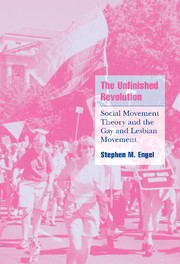Book contents
- Frontmatter
- Contents
- Notes on language
- Preface
- Introduction
- 1 Asked and answered: how questions can condition conclusions in social movement theory
- 2 Tracing the rainbow: an historical sketch of the American gay and lesbian movement
- 3 Tracing the rainbow: an historical sketch of the British gay and lesbian movement
- 4 Where and how it comes to pass: interest group interaction with political institutions
- 5 Asking the unasked question: grappling with the culture variable
- Conclusion
- Appendix: a survey of social movement theories
- Notes
- Bibliography
- Index
2 - Tracing the rainbow: an historical sketch of the American gay and lesbian movement
Published online by Cambridge University Press: 31 October 2009
- Frontmatter
- Contents
- Notes on language
- Preface
- Introduction
- 1 Asked and answered: how questions can condition conclusions in social movement theory
- 2 Tracing the rainbow: an historical sketch of the American gay and lesbian movement
- 3 Tracing the rainbow: an historical sketch of the British gay and lesbian movement
- 4 Where and how it comes to pass: interest group interaction with political institutions
- 5 Asking the unasked question: grappling with the culture variable
- Conclusion
- Appendix: a survey of social movement theories
- Notes
- Bibliography
- Index
Summary
To be overtly homosexual, in a culture that denigrates and hates homosexuals, is to be political.
Michael BronskiAn historical analysis of the American gay and lesbian movement utilizing the political process model seeks to answer a variety of questions. What changing opportunity enabled the movement even to be contemplated? What types of organizations existed to capitalize on this opportunity? When did members of this disenfranchized minority realize their inherent agential power thereby experiencing cognitive liberation? What organizations did the movement spur? What type of response did the movement elicit from both the government and other citizens? How has the movement changed over the course of its existence? What factors have influenced this change? This chapter attempts to address these questions by sketching the evolution of the American gay and lesbian movement throughout the post-war period. Starting with an analysis of the effect of the Second World War on homosexual identity and community, this chapter traces the development of the homophile movement of the 1950s and 1960s, explores the effect of the Stonewall riots of 1969, examines the ideology of gay liberation in the 1970s, analyzes the complex impact of AIDS on the movement, and assesses current notions of gay and lesbian visibility and the present status of the movement. Although homosexuals have obviously existed before this time, and a homosexual subculture had been emerging since the late nineteenth century, the onset of the Second World War ushered in a new era of visibility that would profoundly shape not just the lives of American gay men and lesbians, but question the understanding of sexuality itself.
- Type
- Chapter
- Information
- The Unfinished RevolutionSocial Movement Theory and the Gay and Lesbian Movement, pp. 19 - 66Publisher: Cambridge University PressPrint publication year: 2001



